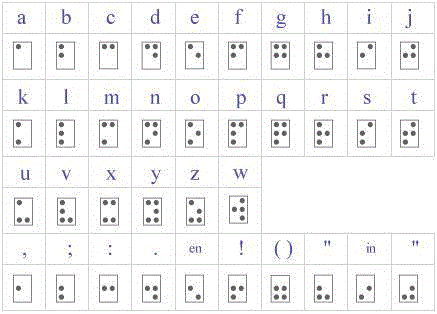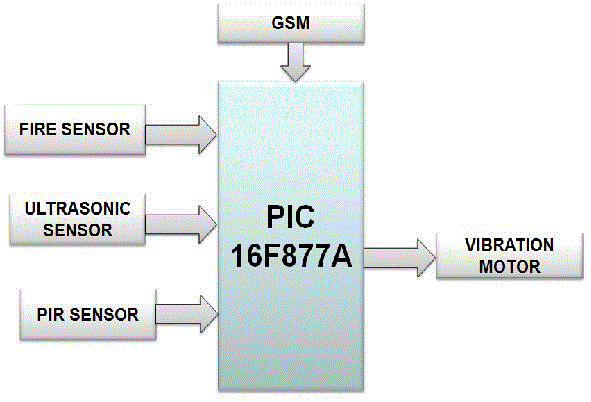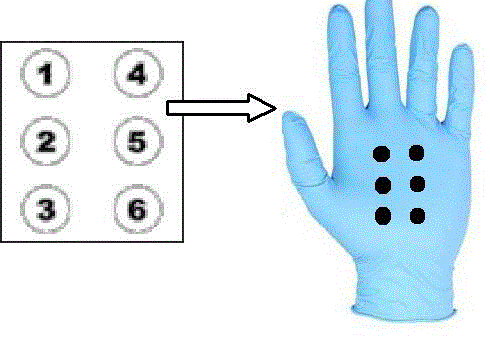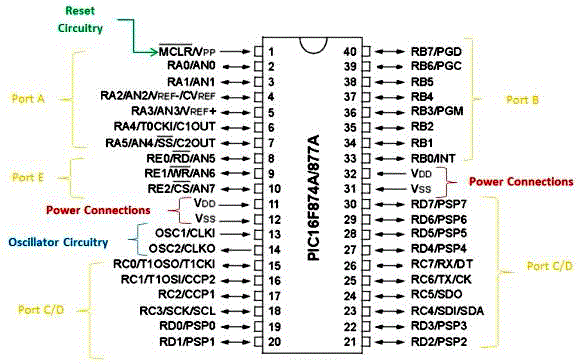Keywords
|
| Arduino IDE, Ultrasonic Sensor, PIR Sensor, GSM SIM900, Vibration motor |
INTRODUCTION
|
| Disabled person can be categorized in some classes such as deaf, blind, physical disability etc. Of all disabilities, the person with visual impairment is of great danger. Vision is the main cue used by humans in obstacle avoidance that is performed by the automatic processing of eyes with minimum cognitive effort and is seen as a trivial task to the visually able navigator. In contrast, for a visually impaired person, vision must be substituted by either auditory or tactile senses and it is a stressful and cumbersome process which is cognitively demanding. According to their motion properties, obstacles are categorized as static and dynamic. To avoid them and aid mobility, several traditional travel aids and electronic travel aids (ETA) are being introduced. |
| According to the WHO recent statistics, 314 million people are visually impaired worldwide. Among these 45 million people are blind and 269 million people have low vision conditions. About 90% of the world’s visually impaired live in developing countries in which only 15% are affordable to an ETA. The number has been estimated to increase highly in the forthcoming years. It is essential to help and assist the people with visual impairment using upgraded technology. In the recent years, researches have been focusing their work in the area of health care. Exploring the outdoor environment has always been a challenge to the visually impaired person. The prevailing navigation systems have to be upgraded to provide a better precision to the visually impaired people. The method used for obstacle detection and the feedback scheme decides the exactness of the result of the system. A wrist mounted model of ETA, the ‘Embedded Glove’ is presented in this paper to assist and aid the visually impaired, to traverse the environment with increased confidence. This system can be used in indoor as well as outdoor environment with ease and high precision. The goal of this paper is to provide a messaging service using the vibrators in the palm using which they can read the message. |
OBJECTIVE
|
| The objective of this proposal is to define and explain the methods in which PIC Microcontroller 16F877 controls the six vibration motor attached to the palm which operates to the corresponding messages. Behind the palm the glove is attached with the ultrasonic, temperature sensor and PIR sensor to detect the presence of human, obstruction and fire respectively. In the presence of fire the buzzer gives a long beep and obstruction gives short beeps with low sound and incase of presence human opposite to them vibration motor on the backside of arm rotates. |
REVIEW OF ALREADY EXISTING METHODS
|
| In the recent years several travelling aids have been developed to assist the visually impaired in safety navigation. These include the Laser Cane, Mowat Sensor, Nav Belt, Sens Cap, Tyflos, Nottingham Obstacle Detector, Path sounder and Binaural Sonic Guide. The shortcomings of these ETAs include the masking effects due to auditory feedback, cost, reduction in walking speed of the user and energy consumption. Several available travelling aids are not accepted by the visually impaired community due to the features of enhanced complexity and high cost. |
| Most of the travelling aids are in the form of the White Cane. The cane is expensive, heavy and also can cover only a limited range in the detection of obstacles. The decision to move in the right direction is taken by the controller that commands the wheel to rotate as required which causes a hidden damage to the brain |
BRAILLE CELL
|
| Standard Braille is an approach to creating documents which could be read through touch. This is accomplished through the concept of a Braille cell consisting of raised dots on thick sheet of paper. The protrusion of the dot is achieved through a process of embossing. A cell consists of six dots arranged in the form of a rectangular grid of two dots horizontally and three dots vertically. With six dots arranged this way, one can obtain sixty three different patterns of dots. A visually Handicapped person is taught Braille by training him or her in discerning the cells by touch, accomplished through his or her palm. |
PROPOSED SYSTEM
|
| The hand glove consists of the PIC microcontroller which controls the input from the GSM and sends it to six vibration motor. Fire sensor and ultrasonic gives long and short beep respectively. The PIR sensor which detects the human intrusion makes another vibration motor which is connected to the backside of palm to rotate. |
DESIGN CONCEPT
|
| The Braille hand glove will be comprised of the following components. |
| PIC MICROCONTROLLER 16F877 |
| PIC 16F877 is a 40 pin microcontroller, irrespective of their complexity, are based on similar building blocks as other microcontrollers. It is a CMOS flash based memory 8 bit microcontroller |
| • CPU - the part that does all logic and arithmetic functions |
| • RAM - Storage for programs and/or program variables |
| • ROM - read-only part of programs |
| • I/O - connection to external devices. |
| It has a flash memory of 14.3 Kbytes. A microcontroller is a stripped-down version of the very same architecture, with all the important features placed on one chip. The microcontroller based circuit does not require any extra additional circuitry except the clock input. The difference between the microprocessor and the microcontroller arises because of their different end-usage. The microcontroller that will be investigated is the PIC16F877, wh i ch is at the upper end of the mid-range series of the microcontrollers is used in wide range of safety robots. |
A. GSM(Global System for Mobile Communication)
|
| GSM is a cellular network, which means that cell phones connect to it by searching for cells in the immediate vicinity. Cell horizontal radius varies depending on antenna height, antenna gain, and propagation conditions from a couple of hundred meters to several tens of kilometers. Indoor coverage is also supported by GSM and may be achieved by using an indoor picocell base station, or an indoor repeater with distributed indoor antennas fed through power splitters, to deliver the radio signals from an antenna outdoors to the separate indoor distributed antenna system. These are typically deployed when significant call capacity is needed indoors, like in shopping centers or airports. However, this is not a prerequisite, since indoor coverage is also provided by in-building penetration of the radio signals from any nearby cell. |
B. TEMPERATURE SENSOR
|
| The LM35 is an integrated circuit sensor that can be used to measure temperature with an electrical output proportional to the temperature (in °C). You can measure temperature more accurately than a using a thermistor. The sensor circuitry is sealed and not subject to oxidation, etc. The LM35 generates a higher output voltage than thermocouples and may not require that the output voltage be amplified. The LM35 does not require any external calibration or trimming and maintains an accuracy of +/-0.4 °C at room temperature and +/- 0.8 °C over a range of 0°C to +100°C. Another important characteristic of the LM35DZ is that it draws only 60 micro amps from its supply and possesses a low selfheating capability. The sensor self-heating causes less than 0.1°C temperature rise in still air. Thus when the temperature exceeds 80°C the microcontroller is so programmed that it gives a long beep. |
C. ULTRASONIC SENSOR
|
| Ultrasonic sensors (also known as transceivers when they both send and receive, but more generally called transducers) work on a principle similar to radar or sonar which evaluates attributes of a target by interpreting the echoes from radio or sound waves respectively. Ultrasonic sensors generate high frequency sound waves and evaluate the echo which is received back by the sensor. Sensors calculate the time interval between sending the signal and receiving the echo to determine the distance to an object. |
D. PIR SENSOR
|
| A PIR-based motion detector is used to sense movement of people, animals, or other objects. They are commonly used in burglar alarms and automatic-activated lighting systems. They are commonly called simply "PIR", or sometimes "PID", for "passive infrared detector". All objects with a temperature above absolute zero emit heat energy in the form of radiation. Usually this radiation is invisible to the human eye because it radiates at infrared wavelengths, but it can be detected by electronic devices designed for such a purpose. |
| The term passive in this instance refers to the fact that PIR devices do not generate or radiate any energy for detection purposes. PIRs come in many configurations for a wide variety of applications. The most common models have numerous Fresnel lenses or mirror segments, an effective range of about ten metres (thirty feet), and a field of view less than 180 degrees. |
E. VIBRATION MOTOR
|
| Precision Microdrive’ currently produces coin vibration motors, also known as shaftless or pancake vibrator motors, in Ø8mm and Ø10mm diameters for our Pico Vibe range. Pancake motors are compact and convenient to use. They integrate into many designs, because they have no external moving parts, and can be affixed in place with a very strong permanent self-adhesive mounting system. Enclosures can be easily molded to accept the coin form of the shaftless vibration motors. Within the coin motor range, we offer both leaded and spring & pad mountable versions. Like all of our vibration motors, we are happy to quote for variations to the base design such as a modification to the lead length and also connectors. |
PROCEDURE
|
| The short messaging service which is enabled by means of the input from the GSM is given to the PIC microcontroller. The microcontroller enables the rotation of the corresponding motor for the letter. For example: If the letter is alphabet ‘A’ then the vibration motor ‘1’ rotates so that the vision impaired can sense that the letter is ‘A’. Between each letter there is a time delay of 3 sec and between words the time delay is 5 sec. Thus the vision impaired can be able to understand the text. In the similar fashion we extend it not only to messaging service but also to fire detection, obstacles on the path and human interference. |
CONCLUSION AND FUTURE DEVELOPMENT
|
| The wrist mounted assistive Electronic Travelling Aid for the visually impaired has been designed to be compact, affordable cost and the low power consumption is the striking features of the proposed device. The obstacle detection range and efficiency are reasonably more than the detection range of the existing tracking devices. |
| This project can be further extended to GPS tracking device to know the exact location and the scope for movement of the vision impaired people. Though it’s already present it can be made hand adaptable with the glove. For the people who cannot understand the braille language the system can be connected to the Bluetooth device by means of text to speech convertor in a cost effective way so that they can understand the message. |
ACKNOWLEDGEMENT
|
| We are very much grateful to staffs and head of the department of electrical and electronics, Velammal engineering college who guided us in all phases in bringing out this paper successfully. |
| |
Figures at a glance
|
 |
 |
 |
 |
| Figure 1 |
Figure 2 |
Figure 3 |
Figure 4 |
 |
 |
 |
| Figure 5 |
Figure 6 |
Figure 7 |
|
| |
References
|
- White Cane, "white cane used by blind people" Wikipedia, http://en.wikipedia.org/wiki/White_cane, downloaded in March 2010.International Journal of Emerging Technology and Advanced Engineering, Volume 2, April 2012
- Modeling of Ultrasonic Sensor for Range Measurement for Visually ImpairedInternational Journal of Electrical, Electronics and Data Communication, ISSN (p): 2320-2084,
- ‘embedded glove’ to aid the visually impaired(IJACSA) International Journal of Advanced Computer Science and Applications, Vol. 1, No. 3, September 2010.
- ‘An electrical design of Low cost braille hand glove’International journal on smart sensing and intelligent systems vol. 6, no. 2, April 2013.
- Automated mobility and orientation system.Navigation using Haptic hand mounted device for vision impaired. Kayle and Adam Wolfe.Kelly, G. W. and Ackerman, T., 1982,
- "Sona, the Sonic Orientation and Navigational Aid for the Visually Impaired." 5th Annual Conference on Rehabilitation Engineering, Houston, Texas, p.72.
|